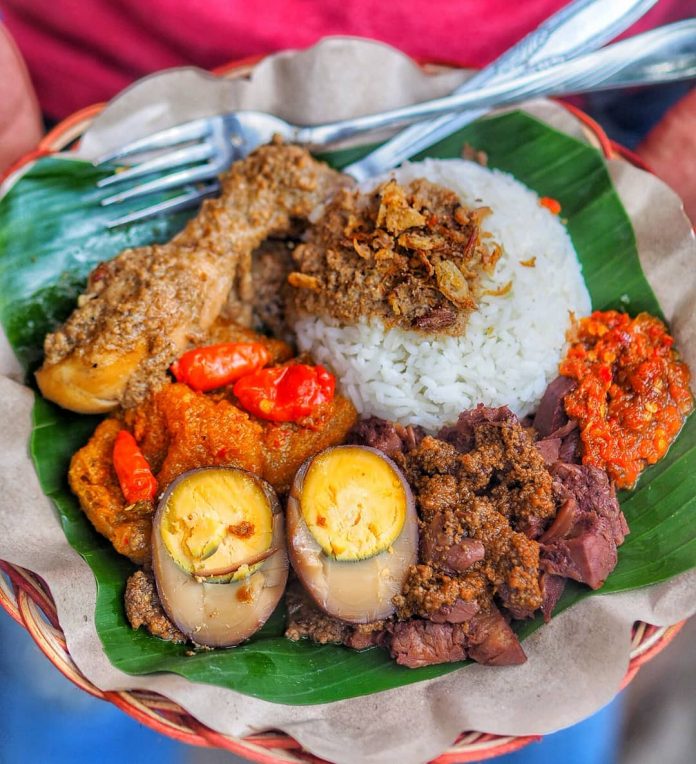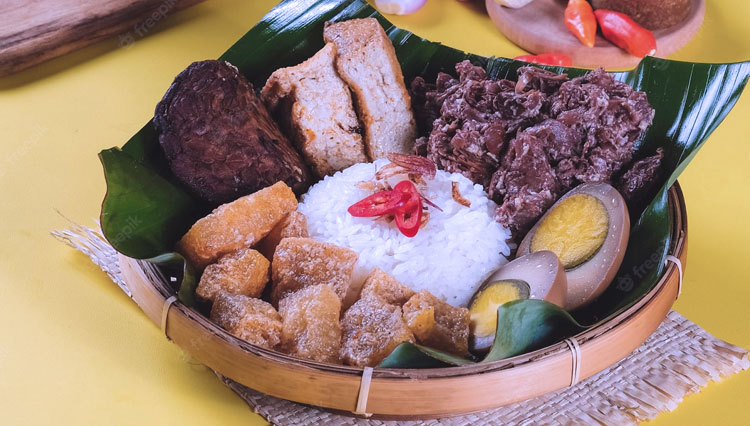A Journey Through the Flavors of Gudeg Jogja: A Culinary Adventure
Related Articles
- A Journey Through The World Of Chinese Dumplings: From History To Your Plate
- A Journey Through Flavors: Exploring The World Of Mie Goreng
- A Deep Dive Into Larb: Exploring Thailand’s Flavorful, Versatile Dish
- A Bowl Of Comfort: Exploring The World Of Japanese Ramen
- A Journey Through The Flavorful World Of Hungarian Goulash: From History To Your Kitchen
Introduction
Discover everything you need to know about A Journey Through the Flavors of Gudeg Jogja: A Culinary Adventure
A Journey Through the Flavors of Gudeg Jogja: A Culinary Adventure

Gudeg, the iconic dish of Yogyakarta (Jogja), is a testament to the rich culinary heritage of Indonesia. This slow-cooked jackfruit delicacy, steeped in history and infused with the flavors of coconut milk, spices, and palm sugar, is a true embodiment of Javanese culinary tradition. While its preparation might seem daunting, the journey to mastering the art of gudeg is as rewarding as the final dish.
Understanding the Roots of Gudeg: A Historical Glimpse
Gudeg’s origins are deeply intertwined with the history of Yogyakarta, a city steeped in Javanese culture and tradition. The dish is believed to have emerged during the Mataram Sultanate era, with its origins possibly traced back to the 18th century. Legend has it that the dish was a favorite of the royal family and was often served during special occasions and ceremonies.
Over the centuries, gudeg has evolved, adapting to the changing tastes and culinary trends of the region. While the traditional recipe remains the foundation, variations have emerged, incorporating local ingredients and techniques. Today, gudeg is not just a dish; it’s a symbol of Javanese identity, a culinary legacy passed down through generations.
Deconstructing the Dish: The Essential Ingredients of Gudeg Jogja
Gudeg Jogja is characterized by its unique blend of sweet, savory, and spicy flavors, achieved through a careful combination of ingredients.
1. The Star Ingredient: Jackfruit
The heart of gudeg is the jackfruit, a versatile fruit with a meaty texture that readily absorbs the flavors of the surrounding ingredients. The unripe jackfruit, with its firm, fibrous texture, is ideal for gudeg. During the cooking process, the jackfruit breaks down, creating a tender and flavorful base for the dish.
2. The Rich and Creamy Base: Coconut Milk
Coconut milk is the foundation of gudeg’s creamy texture and subtle sweetness. Its richness complements the savory flavors of the spices and adds a depth of aroma that enhances the overall taste.

3. The Sweetness of Palm Sugar
Palm sugar, known locally as "gula jawa," contributes the distinct sweetness that defines gudeg. This natural sweetener, derived from the sap of palm trees, adds a unique caramel-like flavor that balances the savory notes of the dish.
4. The Spice Blend: A Symphony of Flavors
The spice blend used in gudeg is a secret recipe passed down through generations. Common ingredients include:
- Turmeric: Adds a vibrant yellow color and a warm, earthy flavor.
- Galangal: Provides a citrusy, pungent aroma and a slightly spicy kick.
- Lemongrass: Contributes a fresh, citrusy aroma and a delicate lemongrass flavor.
- Kaffir lime leaves: Add a fragrant, citrusy aroma and a subtle, tangy flavor.
- Chillies: Provide a varying level of heat, depending on personal preference.
- Salt: Enhances the flavors of all the other ingredients.
5. The Essential Accompaniments: A Symphony of Flavors
Gudeg is rarely enjoyed alone. It is typically served with a variety of side dishes that enhance the overall taste experience:

- Krecek: A savory dish made from beef skin, simmered in spices and coconut milk.
- Opor Ayam: A rich chicken stew cooked in coconut milk with spices.
- Sambal Goreng: A spicy chili paste with a savory base, often made with shrimp paste.
- Telur Pentol: Hard-boiled eggs with a flavorful coating of breadcrumbs and spices.
- Nasi Putih: White rice, a simple yet essential accompaniment to the complex flavors of gudeg.
The Art of Preparing Gudeg Jogja: A Step-by-Step Guide
The preparation of gudeg is a meticulous process that requires patience, precision, and a love for traditional Javanese cuisine. Here’s a comprehensive guide to making your own Gudeg Jogja:
1. Preparing the Jackfruit:
- Choosing the right jackfruit: Select unripe jackfruit with a firm texture and a slightly green color.
- Cleaning and cutting: Wash the jackfruit thoroughly and remove the outer skin and core. Cut the jackfruit into manageable pieces.
- Blanching: Blanch the jackfruit pieces in boiling water for about 10 minutes to soften them and remove any bitterness.
- Preparing the "Blarak": The outer skin of the jackfruit, known as "blarak," is used to add a distinct aroma and flavor to the gudeg. Cut the "blarak" into small pieces and set aside.
2. Preparing the Spice Paste:
- The Spice Blend: Gather the necessary spices: turmeric, galangal, lemongrass, kaffir lime leaves, chillies, and salt.
- Grinding: Grind the spices into a smooth paste using a mortar and pestle or a food processor.
- Sautéing: Heat a small amount of oil in a large pot and sauté the spice paste until fragrant.
3. Cooking the Gudeg:
- Adding the Coconut Milk: Add the coconut milk to the pot containing the sautéed spice paste.
- Adding the Jackfruit: Gently add the blanched jackfruit pieces and "blarak" to the pot.
- Simmering: Bring the mixture to a simmer and cook for 2-3 hours, stirring occasionally.
- Adding the Palm Sugar: Gradually add the palm sugar to the pot, stirring continuously until the sugar dissolves and the gudeg reaches the desired sweetness.
- Slow Cooking: Reduce the heat to low and continue to cook for another 4-6 hours, or until the jackfruit is tender and the flavors have melded.
- Adjusting the Consistency: As the gudeg cooks, it will thicken. Adjust the consistency by adding more coconut milk if needed.
4. Serving the Gudeg:
- Preparing the Accompaniments: While the gudeg is cooking, prepare the accompanying dishes, such as krecek, opor ayam, sambal goreng, telur pentol, and nasi putih.
- Plating: Serve the gudeg on a plate with the accompanying dishes.
- Garnish: Garnish the gudeg with a sprinkle of fried onions for added flavor and visual appeal.
Mastering the Art of Gudeg: Tips and Techniques
Mastering the art of gudeg requires a keen understanding of the subtleties of Javanese cooking. Here are some tips and techniques to elevate your gudeg experience:
1. The Art of Slow Cooking:
- Gudeg is a dish that thrives on slow cooking. The prolonged simmering allows the flavors to meld and the jackfruit to become incredibly tender.
- Patience is key. Don’t rush the cooking process. The longer the gudeg simmers, the more intense and complex the flavors will become.
2. The Importance of Coconut Milk:
- Choose high-quality coconut milk for the richest and most flavorful gudeg.
- Freshly grated coconut milk is ideal, but canned coconut milk can also be used.
- Adjust the amount of coconut milk to achieve the desired consistency.
3. The Role of Palm Sugar:
- Use authentic "gula jawa" (palm sugar) for the most authentic gudeg flavor.
- The amount of palm sugar used will determine the sweetness of the gudeg.
- Add the palm sugar gradually, stirring continuously until it dissolves completely.
4. The Magic of Spices:
- Use fresh, high-quality spices for the best flavor.
- Grind the spices using a mortar and pestle or a food processor to release their full aroma and flavor.
- Experiment with different types of chillies to adjust the spice level to your liking.
5. The Accompaniments: A Symphony of Flavors:
- Choose your favorite accompaniments to create a balanced and flavorful meal.
- Krecek, opor ayam, sambal goreng, telur pentol, and nasi putih are traditional favorites.
- Feel free to experiment with other side dishes that complement the flavors of gudeg.
Beyond the Traditional: Exploring Variations of Gudeg
While the traditional Gudeg Jogja recipe is beloved, there are numerous variations that showcase the versatility of this dish. Here are a few examples:
- Gudeg Kering: A drier version of gudeg, with a more intense flavor and a thicker consistency.
- Gudeg Putih: A lighter version of gudeg, made with white coconut milk and less palm sugar.
- Gudeg Nangka: A variation that uses young jackfruit instead of unripe jackfruit.
- Gudeg Ceker: A version that includes chicken feet, adding a unique texture and flavor to the dish.
- Gudeg Telur: A version that features hard-boiled eggs, often served with a flavorful coating of breadcrumbs and spices.
Gudeg Jogja: More Than Just a Dish
Gudeg Jogja is not just a culinary delight; it’s a symbol of Javanese culture and tradition. It represents the dedication to slow food, the appreciation for local ingredients, and the joy of sharing a meal with loved ones.
The preparation of gudeg is a journey, a testament to the patience and skill of Javanese cooks. Each bite of gudeg is an invitation to savor the rich flavors of this iconic dish, to understand the history and culture that it represents, and to experience the warmth of Javanese hospitality.
So, embark on your own culinary adventure and discover the magic of Gudeg Jogja. It’s a dish that will leave you wanting more, a taste of Javanese tradition that will stay with you long after the last bite.
Closure
Thank you for reading! Stay with us for more insights on A Journey Through the Flavors of Gudeg Jogja: A Culinary Adventure.
Don’t forget to check back for the latest news and updates on A Journey Through the Flavors of Gudeg Jogja: A Culinary Adventure!
Feel free to share your experience with A Journey Through the Flavors of Gudeg Jogja: A Culinary Adventure in the comment section.
Stay informed with our next updates on A Journey Through the Flavors of Gudeg Jogja: A Culinary Adventure and other exciting topics.






